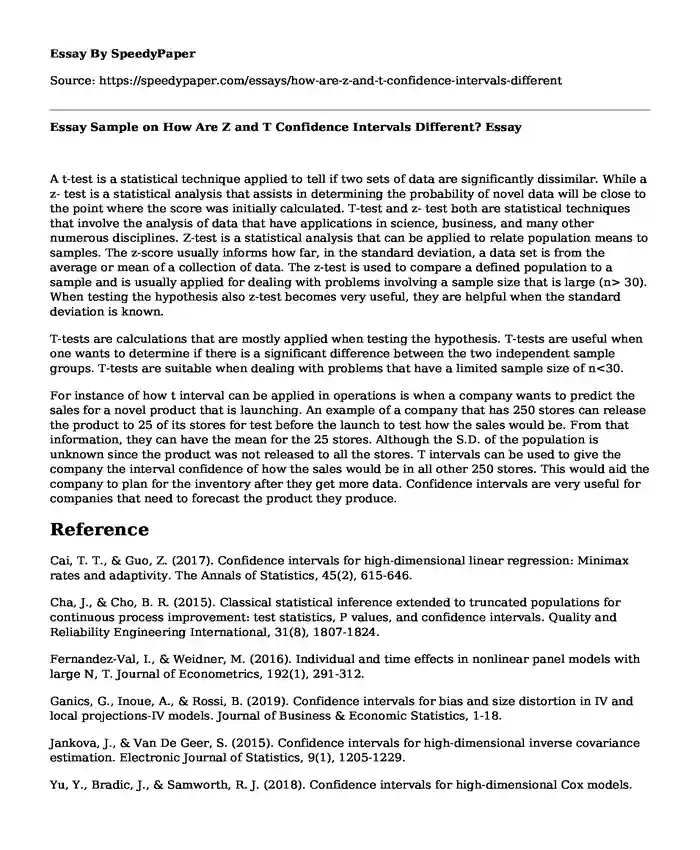
| Type of paper: | Essay |
| Categories: | Data analysis Statistics Systems thinking |
| Pages: | 2 |
| Wordcount: | 478 words |
A t-test is a statistical technique applied to tell if two sets of data are significantly dissimilar. While a z- test is a statistical analysis that assists in determining the probability of novel data will be close to the point where the score was initially calculated. T-test and z- test both are statistical techniques that involve the analysis of data that have applications in science, business, and many other numerous disciplines. Z-test is a statistical analysis that can be applied to relate population means to samples. The z-score usually informs how far, in the standard deviation, a data set is from the average or mean of a collection of data. The z-test is used to compare a defined population to a sample and is usually applied for dealing with problems involving a sample size that is large (n> 30). When testing the hypothesis also z-test becomes very useful, they are helpful when the standard deviation is known.
T-tests are calculations that are mostly applied when testing the hypothesis. T-tests are useful when one wants to determine if there is a significant difference between the two independent sample groups. T-tests are suitable when dealing with problems that have a limited sample size of n<30.
For instance of how t interval can be applied in operations is when a company wants to predict the sales for a novel product that is launching. An example of a company that has 250 stores can release the product to 25 of its stores for test before the launch to test how the sales would be. From that information, they can have the mean for the 25 stores. Although the S.D. of the population is unknown since the product was not released to all the stores. T intervals can be used to give the company the interval confidence of how the sales would be in all other 250 stores. This would aid the company to plan for the inventory after they get more data. Confidence intervals are very useful for companies that need to forecast the product they produce.
Reference
Cai, T. T., & Guo, Z. (2017). Confidence intervals for high-dimensional linear regression: Minimax rates and adaptivity. The Annals of Statistics, 45(2), 615-646.
Cha, J., & Cho, B. R. (2015). Classical statistical inference extended to truncated populations for continuous process improvement: test statistics, P values, and confidence intervals. Quality and Reliability Engineering International, 31(8), 1807-1824.
Fernandez-Val, I., & Weidner, M. (2016). Individual and time effects in nonlinear panel models with large N, T. Journal of Econometrics, 192(1), 291-312.
Ganics, G., Inoue, A., & Rossi, B. (2019). Confidence intervals for bias and size distortion in IV and local projections-IV models. Journal of Business & Economic Statistics, 1-18.
Jankova, J., & Van De Geer, S. (2015). Confidence intervals for high-dimensional inverse covariance estimation. Electronic Journal of Statistics, 9(1), 1205-1229.
Yu, Y., Bradic, J., & Samworth, R. J. (2018). Confidence intervals for high-dimensional Cox models. arXiv preprint arXiv:1803.01150.
Cite this page
Essay Sample on How Are Z and T Confidence Intervals Different?. (2023, Mar 08). Retrieved from https://speedypaper.com/essays/how-are-z-and-t-confidence-intervals-different
Request Removal
If you are the original author of this essay and no longer wish to have it published on the SpeedyPaper website, please click below to request its removal:
- Education Essay Sample: Simple Way to Be a Good Student
- Essay Example on Medical Research Methodology
- Sport Essay Sample: History of Football
- Art Essay Example: The Abduction of Europa
- Free Essay Describing the Evolution of the Definition of Sociology
- Student Mentoring Program Essay Sample
- Essay Sample on the Function of the Opposition in the Poem
Popular categories




